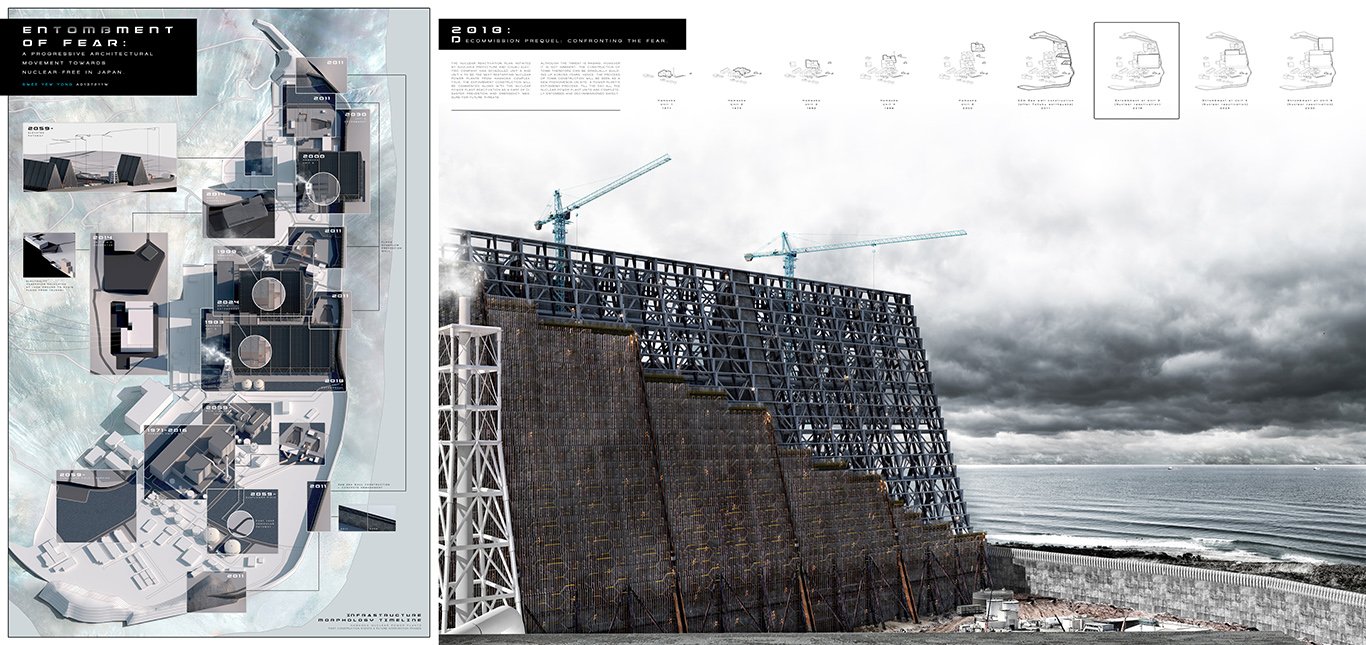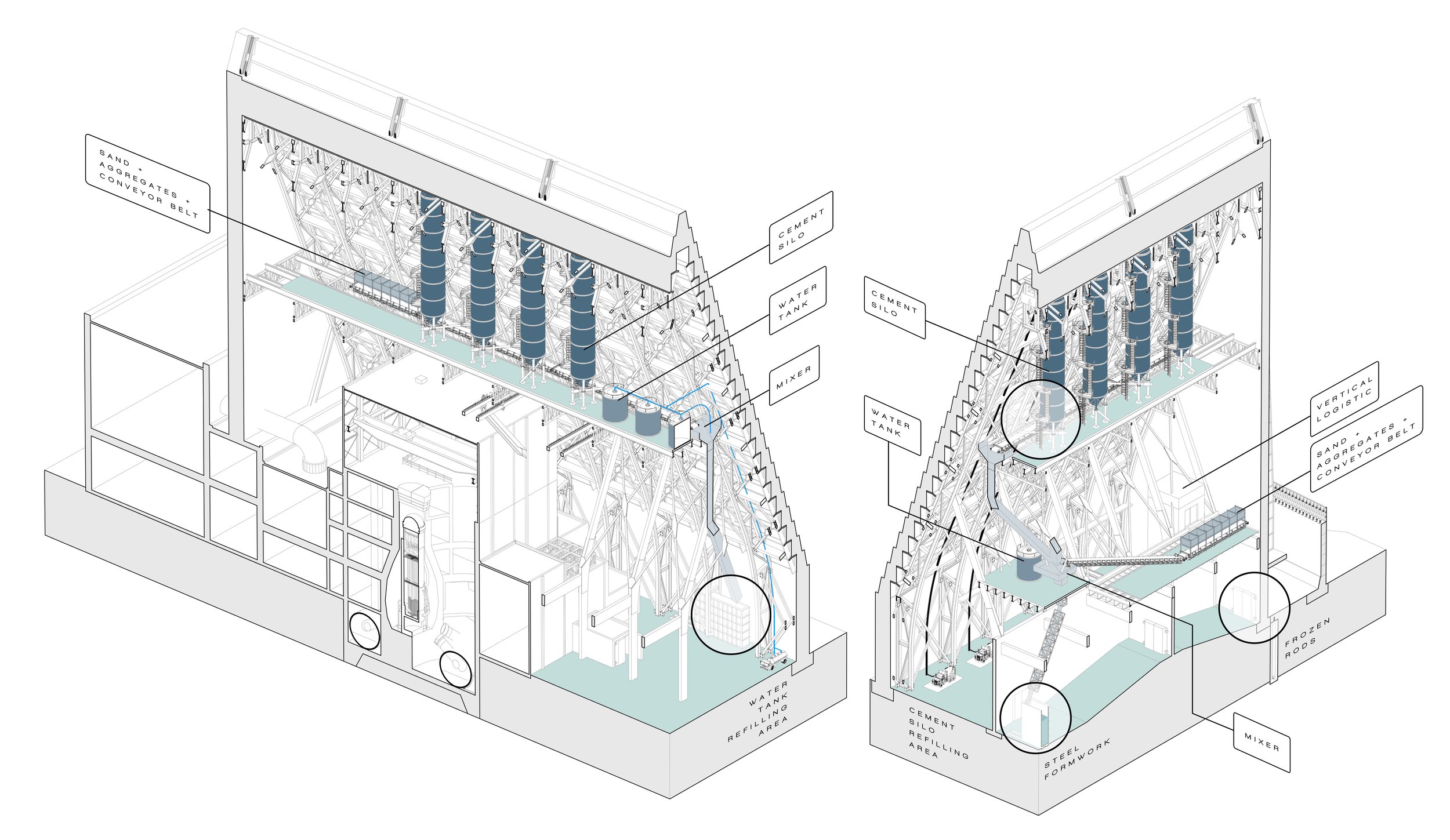
ENTOMBMENT OF FEAR
A PROGRESSIVE ARCHITECTURAL MOVEMENT TOWARDS NUCLEAR-FREE JAPAN
-
“We begin with something exciting, soon the mistake happened then we start to compromise, we create our own demon.” - Tony Stark, Iron Man 3
Nuclear power generation, one of the greatest inventions to secure future energy has become an issue that threatens us. We hope to live without putting our lives, our loved ones and our future under risk, in the name of technological advancement. But sometimes risk has become a necessity for human civilization. Historically mankind has made high-risk decisions in order to move the society forward, and at time it may result in sacrifice, horror, trauma and post-traumatic stress like fear and anxiety. An example of such risk is the usage of nuclear energy in Japan.
Unfortunately, Fukushima triggered the Tohoku undersea earthquake and tsunami in 2011 that brought devastation to the region where the Fukushima Daiichi Nuclear Power Plants is located. This deathly event caused nuclear reactor meltdown and created an irreversible environmental damage at a global scale. This unprecedented disaster led the Japan government to re-examine nuclear power generation in high seismic zones and subsequently the suspension of all nuclear power plants’ operations across the nation.
The proposed energy generation system through nuclear fission is supposed to perform flawlessly in an ideal condition, but contingencies always occur in reality. Consequently, the question of how such contingency should be handled has become a major concern since its invention in the 1940s. Until today, it is still unclear on the proper way to handle a nuclear disaster, and this has resulted in a perceived fear in adopting nuclear as an energy source.
However, nuclear reactivation is inevitable for resource-poor Japan. Japan can upgrade their nuclear technology to one that is safer, but the public sentiment towards nuclear power generation in Japan remains challenging to overcome. The balance between the continuation of nuclear power generation and the negative public sentiment towards it needs to be worked out in a tactful approach.
By taking Chernobyl New Safety Confinement (NSC) as the precedent study - the process of entombing the damaged nuclear reactor has inspired the thesis to explore the idea of entombment as a solution to strive the balance between public sentiment and nuclear power generation. The entombing of nuclear plants sends the message that nuclear energy is being phased out and the entombment also provides a sense of safety for the people of Japan.
This thesis, therefore, aspires to propose entombment for Hamaoka nuclear power plants in Omaezaki due to the region is anticipating an earthquake within the next 30 years. Taking into account the fear and anxiety caused by previous nuclear accidents, the entombment design aims to provoke fear and raises the awareness about the limitation of technology. In addition, it also demonstrates the nation’s strong determination to phase out nuclear power usage through entombment build-up for Hamaoka nuclear power plants.
Ultimately, the thesis envisages that through entombing the Hamaoka nuclear power plants in Omaezaki, it will aid in the progressive phasing out of nuclear energy while providing the energy needed until Japan has adopted an alternative energy option in the near future.
-
TYPOLOGY: Energy Infrastructure, Masterplanning
PROGRAM: Nuclear Power Plants, Dark Tourism
YEAR: 2018
STATUS: Concept, M.ARCH Thesis
-
NUS PIONEER ARCHITECT PRIZE 2018
WINNER OF PERTUBUHAN ARKITEK MALAYSIA (PAM) STUDENT AWARD SILVER MEDAL 2019
SHORTLISTED: THE ARCHITECTURE DRAWING PRIZE 2020, CURATED BY SIR JOHN SOANE MUSEUM & MAKE ARCHITECTS
C-IDEA DESIGN AWARD 2020: NEW STAR AWARD UNDER ARCHITECTURE & LANDSCAPE CATEGORY
INTERNATIONAL EXHIBITION FOR ARCHITECTURE GRADUATE DESIGN (IEAGD 2018) IN YILAN, TAIWAN
PROCESS AS NEW FORM OF MONUMENTALITY
Hamaoka nuclear power plant complex went through different phases of construction and infrastructure upgrade throughout decades as showed in the morphology timeline diagram. From building, deactivating, upgrading and now restarting, it shows a close relationship between the nuclear power plants and the issues related to politics, environment and economy in both domestics and global scale. As now the state is restarting the power plants in order to reinvigorate its economy. Hence, the thesis proposes to design the next phase for Hamaoka nuclear power plants: An entombing process, due to the proliferated fear and anxiety created by the nuclear reactivation.
In order to entomb the highly radioactive nuclear power plant, the choice of construction material is crucial. Based on the suggestion from precedent study (Chernobyl concrete sarcophagus) and literature review, concrete has excellent durability and good in radiation shielding due to the high density of the material. Furthermore, the process of formwork making and concrete casting will also manifest the spirit of craftsmanship. The concrete making process will reflect not only the physical requirement of entombment but also the ontological meaning of structure.
Ultimately, the long-duration of entombing process expresses as a new form of monumentality of place, a never-ending-process that symbolizes the spirit and determination of people that stand against nuclear power generation.
Entombing the Fear
The thesis design takes nuclear power plants’ entombment, and interim spent fuel facilities as a compulsory term and condition for the reactivation of Hamaoka nuclear power plants. The term of “entombment” is suggesting an end or termination of life. However, the entombment will not terminate the operation of Hamaoka nuclear power plants promptly. It will only be entombed and annihilated entirely through automated concrete pouring when the emergency situation (natural disasters or meltdown) occurred, or an alternate renewable energy option has been invented to replace nuclear power generation.
There are 2 scenarios that the thesis design is speculating:
1) Contingency happened and the mechanism of tomb will be activated to minimize the aftermath impact from meltdown.
2) A peaceful phase out of nuclear power plants in Japan before the contingency happened.
2018 Decommission Prequel: Confronting the fear
The nuclear reactivation plan initiated by Shizuoka prefecture and Chubu electric company has scheduled unit 3 and unit 4 to be the next restarting nuclear power plants from Hamaoka complex. Thus, the entombment construction will be commenced along with the nuclear power plant reactivation as a part of disaster prevention and emergency measure for future threats. Although the threat is raging, however it is not imminent, the construction of tomb therefore can be gradually building up across years. Hence, the process of tomb construction will be seen as a new phenomenon on site- a power plant’s entombing process, till the day all the nuclear power plant units are completely entombed and decommissioned safely.
2036 Dehumanization of space
As the construction of tomb has been carried out for decades following up with the nuclear power plants’ reactivation, thus before 2040, the three entombments for Hamaoka Unit 3, 4 and 5 will be scheduled for completion and ready to face the catastrophic disaster in the near future.

Structural Analysis
2042 The act of God and The entombment
On the day when the anticipated disaster arrives, the tomb will be immediately concealed by concrete through automated concrete batching and pouring system.
The moment when tsunami invades the nuclear power plants complex will be a testimonial of how mankind goes against the power of Mother Nature. In Japanese word (想定外 sou-te-gai), which means beyond the expectation, preparation for the unknown threat is always insufficient as there are contingency and unexpected event. We can only base on the information and technology we have on hand and do as much as we can to protect the vulnerable Hamaoka nuclear power plants, once and for all.
2043 Post-disaster measures
Right after the outbreak of natural disaster, the entombment is designed to repair the damaged structure in order to prevent any potential radiation leakage. At the lower part of entombment wall, the steel structure is designed to support the main wall and to allow scaffolding to be set up on-site for structural amendment works.
The repairing works have to be completed within a tight frame of time in order to prevent any failure of structure that would result in significant consequences. Therefore, the original tomb surface cannot be fully restored due to the lower quality of workmanship. The unevenness of the concrete surface will represent a visual layer of contingency. Like a scar on the skin, although it is healed, however, it cannot be completely recovered from past year incident that caused the wound.
2059 Sequel: Ruin as a visual palimpsest of place
From the predicted scenarios, Hamaoka nuclear power plants are expected to be fully decommissioned once Japan has adopted an alternative energy option or once after the anticipated disaster.
The decommissioned nuclear power plant complex will be soon planted with sunflower as people believe the flower might be able to detoxify the site from radioactive substances. Eventually, the landscape on site will become a symbolic representation of the spirit of people that try to recover from trauma, a hope for people who have suffered from the pain.
In the later years after decommissioning, a series of additional work will be added to create a route for tourists to sightsee. All the structures will be integrated with the existing structures in order to minimize the impact on the original fabric. The elevated walkway on-site marks as a demarcation that detaches from the contaminated ground and represents another layer of circulation for the new programme.
At the end of the line, the complex will be overturned from a dehumanized space into a place reclaimed by nature. Nonetheless, the mystic of place is not fully revealed as the tomb is still remaining concealed and distant away from human beings with its monolithic and monumental expression. What has left in our mind is the fear from the anthropocentric object we created which goes against the rule of nature.































